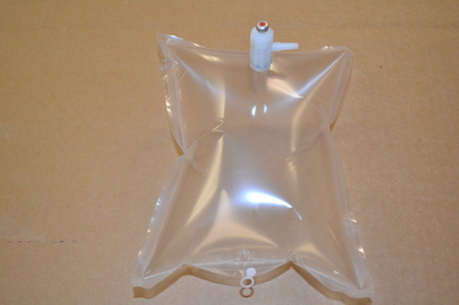Tedlar Bag
The Tedlar bag is used to collect gas or air sample for sampling. Hence it is also known as a gas sampling bag and air sampling bag. It is mainly utilized to sample VOC’s, CO, CO2, and other effluent gasses. The sampling bas is made up of PVF (polyvinyl fluoride) film, which operates at a high temperature. The commercial name of PVF is the Tedlar. Hence it is called as a Tedlar bag.

The main properties of a PFV/Tedlar sampling bags are:
· High resistance to greater temperature levels
· Comprehensive chemical inertness
· Corrosion-resistant
· Abrasion-free
· High tensile strength
· Lowest absorption rate
· Higher resistance to gas permeability
Standard operating guide for the gas sampling bag
1. Select a Tedlar bag of required capacity.
2. Make sure that, it should not contaminate by any means.
3. Keep a gas collection pump or manual blower available with all the required accessories.
4. Connect the rubber tube to the hose provided at PTFE duel functioning valve and then open the valve.
5. Start filling the Tedlar bag up to 90% of total capacity to avoid the leakages and bag deformation.
6. As soon as the sampling bag filled up to its limit, close the functioning valve and remove the tube from the hose.
7. There is a detachable silicon septum supplied separately, which should be attached to threaded hose at the valve.
8. Tighten the septum to make sure that, it should be completely leak-proof.
9. The Tedlar bag can retain the gasses sample up to 3–4 days without any losses.
10. Then take a gas syringe and load the sample for sampling in gas chromatography or other devices.
11. The silicon septum should replace after 120 to 130 sampling to avoid leakages.
12. For reuse, flush the Tedlar bag thoroughly with inert gas or purified air 2–3 times or researcher may vacuum the gas sampling bag with the help of a vacuum pump.
13. Avoids the direct contact of the Tedlar bag with fire and allow sampling below 200-degree Celsius temperature.
Step involve in Tedlar bag cleaning
These are the step involves in cleaning of Tedlar bas to reuse for experiments
1. Fill the Tedlar bag with nitrogen gas (99.9%) and wash 2 times by removing nitrogen gas from bag.
2. In the next step again fill the Tedlar bag with nitrogen gas and put it under the IR lamp for 1 min.
3. Again wash Tedlar bag with nitrogen gas by gently worm bag and repeat this 2 times
Reuse of Tedlar bags
These bags are to be used to collect air samples containing methanol or other low molecular weight alcohols, analysis should be conducted within the first 24 hours to ensure accuracy of results. Beyond the 24-hour period, levels of methanol and possibly other low molecular weight alcohols drop as adsorption occurs.
The desorption study failed to reverse the adsorption of methanol, either by flushing, standing for 24-hour periods, or by heating, indicating a degree of irreversibility.
Allyl alcohol adsorbed to the Tedlar bags and losses averaged 10% in the first 5 days. Holding times of 5 days or less are recommended for this and other high molecular weight alcohols.
Residual allyl alcohol at the end of the adsorptive stage was removed easily and completely. It seems reasonable to reuse Tedlar bags in the collection of higher molecular weight alcohols after adequate flushing, without compromising the integrity of subsequent analyses.
Propylene oxide adsorbed to the surface of Tedlar bags very slowly and to an insignificant degree; analysis of samples within 5 days should result in no greater than 5% loss. Further, it was easily removed, indicating that Tedlar bags may be reused after flushing five times with N2 when the bag has previously contained propylene oxide or another similar epoxide.
MtBE did not adsorb in Tedlar bags, and cleaning of the bags was simply a matter of emptying the bag of MtBE. It is reasonable to expect that Tedlar bags may be used to collect samples of ethers, and cleaned and reused without compromising subsequent analyses. Sample holding time does not appear to affect the observed concentration of ethers in Tedlar bags.
The study indicates that Styrene and ethylbenzene losses to adsorption were significant, and simple flushing did not completely remove these compounds. Off gassing occurred when the bags were allowed to stand overnight, an effect that was accelerated in the heating step. Tedlar bags cannot be reliably reused with these compounds, and their initial use when new should be limited to short holding times.
Long-term storage of compounds in Tedlar bags is not recommended because significant adsorptive losses to the bag surfaces can occur. In addition, it is recommended that bags that are to be reused should be cleaned immediately after their use by a rigorous flushing and heating procedure, then stored in an evacuated state.
Study indicate that, with the exception of methanol and styrene, little adsorption occurs in the first 5 days of storage. Long-term storage of contaminated samples in Tedlar bags, followed by cleaning and reuse of those bags, can lead to significant off gassing of contaminants into subsequent samples.
Future work with Tedlar air sampling bags should include testing with other classes of compounds not examined here, such as aldehydes, ketones, halogenated hydrocarbons, amines, nitrated compounds and oxides of N2, and other common inorganics such as carbon monoxide, sulfur dioxide, and other sulfur compounds.
References
2. The Effects of Adsorption on the Reusability of Tedlar® Air Sampling Bags. AIHAJ — American Industrial Hygiene Association, 61(3), 375–380.
3. sigmaaldrich.com
